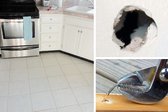
Although some maintenance projects are best left to the pros, these three easy DIY fixes will give you bragging rights.
We turned to three bloggers for ideas on how to tackle some little, but nagging, household wall and floor issues.
A Made-Up Drywall Repair
The problem: Concealing drywall damage is a tricky business that requires a handful of drywall tools and materials to make walls look like new. To fix coin-sized holes, many traditionalists use mesh or paper tape. But not Lesli DeVito, the DIY blogger behind My Old Country House.
The fix: Cosmetic wedges! DeVito first tried patching the two nickel-sized openings with cement board she had lying around, but the pieces didn’t fit as you can see in the picture below (left).
{{ include_comparison_image 38 }}
Tool list:
Make-up sponges
Scissors
Spackle
Putty knife
Sandpaper
How to:
Cut the wedges into pieces that are slightly larger than the holes.
Spackle the drywall and wipe off the excess.
When the spackle dries, sand the area until it’s smooth.
Add a fresh coat of paint.
Now DeVito challenges people to find where the holes were; go ahead, take a peek.
Related: Another Clever Drywall Fix
A Seamless Way to Remove Nails from Trim and Flooring
{{ include_photo repair-drywall-remove-nail-floor }}
The problem: You can save some dough by using salvaged materials like trim and oak flooring. But before you can install or even safely store them, you have to pull out any old nails — without damaging the wood.
The fix: Although you might be tempted to whack the nail from the back with a hammer and then yank it, don’t. That can mar the surface. Instead, pull the nails out from the back, says Peter Fazio from the site Dadand.
Tool list:
Pliers
Work gloves
Drop cloth
How to:
Put the trim or floorboard face down on a drop cloth to protect the front surface.
Using your pliers, grab the nail and gently roll onto the curved part of the tool until the nail pops out.
If the old filler used to conceal the nail on the front side pops out, it’s easy to fix. Refill the hole with color-matched wood filler (it’ll work for composite trim, too). Scrape the top of the repair gently with a putty knife to remove excess filler — otherwise you’ll leave a noticeable bump.
If you can’t find color-matched filler, repair the hole and gently sand the area smooth. Spot paint to match.
The Trick to Spiffing Up Grody Grout
{{ include_photo repair-drywall-cleaning-grout-before }}
The problem: When Virginia from LiveLoveDIY painted her kitchen cabinets bright white, her dingy tile grout became a real eyesore.
Sure, cleaning agents like hydrogen peroxide can brighten discolored floors, but they won’t do much for grout. Grout is gritty and easily stains; despite scrubbing, it may never appear clean.
The fix: Using what she calls the “best product ever,” a bottle of Polyblend Grout Renew (there are other brands, too), a stain- and fade-resistant grout paint in snow white. It cost $10 for an 8-ounce bottle, which was enough to cover the all grout in her kitchen.
{{ include_photo repair-drywall-cleaning-grout-after }}
Tool list:
Grout paint
Toothbrush
Rags or paper towels
How to:
Squeeze a dollop of paint on the grout and scrub it in with a toothbrush. (The paint Virginia used dries fast, so you’ll need to work quickly.)
Wipe off the excess from tile with a paper towel.
Including a few breaks, it took her about four hours to complete the job, which she says was time well-spent. Virginia also says the grout paint is easy to keep clean.
Tip: You might also want to seal the grout paint after it dries.



